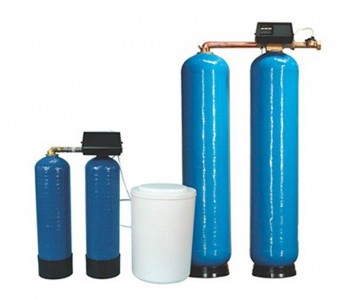Loading...
Softening Systems
 Su yumuşatma cihazları, iyon değişimi prensibine göre çalışarak sudaki sertliğe neden olan Ca Water softening devices are resinous units which operate on the principle of ion exchange and remove Ca (Calcium) and Mg (Magnesium) ions that cause the hardness of water. Hardness Hardness is a parameter that equals the total of the ion concentration of calcium and magnesium ions in water. These ions pass to the constitution of the water in the course of its natural cycle in soil, rocks, and reservoirs (e.g. natural and artificial lakes, sea, stream) as a result of the dissolving of the minerals and salts during the storage or movement of the water. Especially water with a high degree of hardness causes Ca and Mg ions to settle and form deposits in many kinds of systems from the simplest water transfer installations to hot water and steam boilers. It also causes problems such as the petrification of these deposits in time, heat transfer, constriction, blockages and corrosion.
Su yumuşatma cihazları, iyon değişimi prensibine göre çalışarak sudaki sertliğe neden olan Ca Water softening devices are resinous units which operate on the principle of ion exchange and remove Ca (Calcium) and Mg (Magnesium) ions that cause the hardness of water. Hardness Hardness is a parameter that equals the total of the ion concentration of calcium and magnesium ions in water. These ions pass to the constitution of the water in the course of its natural cycle in soil, rocks, and reservoirs (e.g. natural and artificial lakes, sea, stream) as a result of the dissolving of the minerals and salts during the storage or movement of the water. Especially water with a high degree of hardness causes Ca and Mg ions to settle and form deposits in many kinds of systems from the simplest water transfer installations to hot water and steam boilers. It also causes problems such as the petrification of these deposits in time, heat transfer, constriction, blockages and corrosion. These factors damage the existing installation and equipment and cause higher energy consumption, the result of which is higher costs. Ion exchange The dissolved minerals in water (ions) can be positively or negatively charged with electrons. Generally ion forms with positive ions are +2 degree Calcium, Magnesium, Iron and Manganese and these are the ions that cause hardness in water. The process of removing these positively and negatively charged ions from the water and to replace them with other ions with the same charges and thus keep the ion balance in the water is known as ion exchange. Special material generally named as resins are used for the exchange of ions in softening systems. Resin Resin is a material that is artificially produced containing various cross linked polymers of ionic or cationic character. When it contacts water it has the characteristic of exchanging the main ion in its constitution with similarly charged ions in water. The cationic type ion exchanging resins used in the removal of hardness in water are sodium (Na) based resins and transfer the sodium ions in their own constitutions while holding the calcium and magnesium in the water. In water softened by this method there are no Ca and Mg ions while the sodium ion concentration is high. However, high sodium concentration does not effect the usability of water negatively. Ion Exchange capacity The resin which exchanges the Ca and Mg ions in water with the Na ions in its constitution, consumes the Na ions after a while. At this point the ion exchange activity reduces and water that contacts the resin cannot be softened. The ion exchange capacity of the resin is measured by the amount of Na ions that can be exchanged with Ca and Mg ions until this point is reached. The consistency of ion exchange is directly related to the resin regeneration. Regeneration The process of incorporating ion exchange capacity to resin that has exchanged all its Na ions with Ca and Mg ions and thus has no longer the capacity of exchanging ions is called regeneration. The basis of the regeneration process is to reload Na ions to the resin. The regeneration of Na based resins is carried out by using salt (NaCl).
The regeneration principle Our water softening devices have the feature of automatic regeneration. The regeneration of the resin is realized by the separation of Na and Cl ions in salt water, the loading of Na ions to the resin during the washing of the resin with this salt water, the rinsing of the Cl ions together with the Ca and Mg ions that have been collected on the resin during the softening process and their transfer to the drainage. With this method, the resin that has lost its softening capacity is regenerated and is ready to do the softening process once again. Automatic regeneration control is maintained as follows: Volumetric control The volume of water that passes through the device is measured by a counter. The counter is set to carry out the regeneration process automatically after a specified volume of water has passed through. Time control With the help of a timer, automatic regeneration command at the desired frequency is given to the device. (Time dependent automatic control is preferred in low capacity systems for economic reasons.)
The input water of the softening device should not contain any residue and bacteria.
The input water of the softening device should contain <1 mg/lt active chlorine.The amount of chloride in the input water of the softening device should be < 340 mg/lt. Range of Softening Systems; Just as in sand filters and active carbon filters, softening systems are divided into two as surface piped systems and fleck controlled systems depending on the operating principle. Single tank and double tank tandem ranges are available. Mini cabinet and micro cabinet ranges with low capacity known as mini softening ranges are also available.




